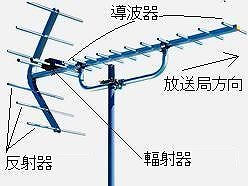Yagi antenna (Yagi-Uda antenna)
Yagi-Uda antenna, the Yagi Hidetsugu, and was developed by Uda Shintarou antenna. For FM and TV broadcast reception, amateur radio is often used for such operations, usually called the Yagi antenna.
Yagi antenna structure and characteristics for UHF television

Yagi antenna towards the station, as this photo, after the reflector, radiator, director of each element is arranged, only to feed waveguide The structure is.
Half-wave reflector (1/2λ) is slightly longer than the rod. It becomes the radiator or its application to the antenna half-wave dipole antennas. The general director is trying to stick a little shorter than half wavelength.
Yagi antenna has a directivity in this direction is the direction of the reflector waveguide. That is, if the receiving antenna is the direction of the station's orientation and Waveguides.
14 element Yagi antenna for terrestrial digital photo, a reflector element (6), the radiator element 1 (2), the waveguide element 12 has become. The radiator for the band and seems to have become two of the Phased Array.
Yagi voltage, current distribution
Voltage of each element Yagi antenna, half-wave current distribution (1/2λ) is similar to the dipole. In other words, the tip of the rod antenna voltage and current is zero, the largest in the middle of the rod antenna is the minimum voltage and maximum current.
The reflector is induced, so longer than the resonant frequency (L), and current phase current flows later than the current phase of the radiator, waveguide is capacitive, so shorter than the resonant frequency (C), and current flows through the current phase is a more advanced phase of the current radiator. That are shaped by this directive.
Voltage of each element Yagi antenna, half-wave current distribution (1/2λ), so the same dipole antenna close to an object, you must point away from the maximum possible voltage. If the state line will not come close to yagi antennas, for example, must be a minimum point voltage.
On the mast that you will not be affected much if the boom is approaching the status line. But it is desirable to avoid the area around the radiator as possible.
Relationship between gain and directivity of Yagi antenna element number
A typical Yagi antenna reflector element 1 to 2, the waveguide is sensitive to those using the directional multi-element, that has a higher gain.
Yagi antenna gain is generally greater the larger the number of elements. UHF (ultrahigh frequency) television broadcasting reception device of about 14 (gain of about 10dB) is often used. Weak field region is more commonly used elements of 20.
Yagi antenna reflector is a small number of common elements. This is because even a small gain, multi-reflector element.
In addition, to improve the gain and the directivity, the antenna of 20-30 element for the distance reception is stacked. It makes it to 2-4 step, and in a word, it sideways makes to 2-4 row and it synthesizes it to length with the mixer. A vertical directivity improves to length when stacking, and the directivity in a horizontal plane sharpens when sideways stacking. The gain increases theoretically by 3dB when it is adjusted to two. In this case, the improvement of the gain is actually little because there are about 2 dB mixture loss.
Radiator for a device of the broadband Yagi antenna
In general, the radiator and deformation of two phase feed antenna folded dipole and half wave dipole and the like are used to AWX.
Especially since the TV using a wide frequency bandwidth, broadband characteristic are required. Therefore, the radiator element and a thicker, deformed and Phased Array Antenna and two folded dipole folded wider AWX has to be devised to broadband.
Yagi antenna applications
Antenna very similar in shape and form Yagi antenna, Phased Array (HB9CV antenna) and the log periodic antenna are. These are all elements that are fed antenna, Yagi antenna is the reflector or director has become a natural feature of the current flowing through the different phases without power.
- Compact Yagi antenna with loading coil
- Provided in the middle of a parallel resonant circuit element yagi with a multi-frequency method of operating at multiple frequencies by disconnecting the electrical elements for his future
- There is also a loop yagi antenna arrangement as one wavelength loop.